Menu
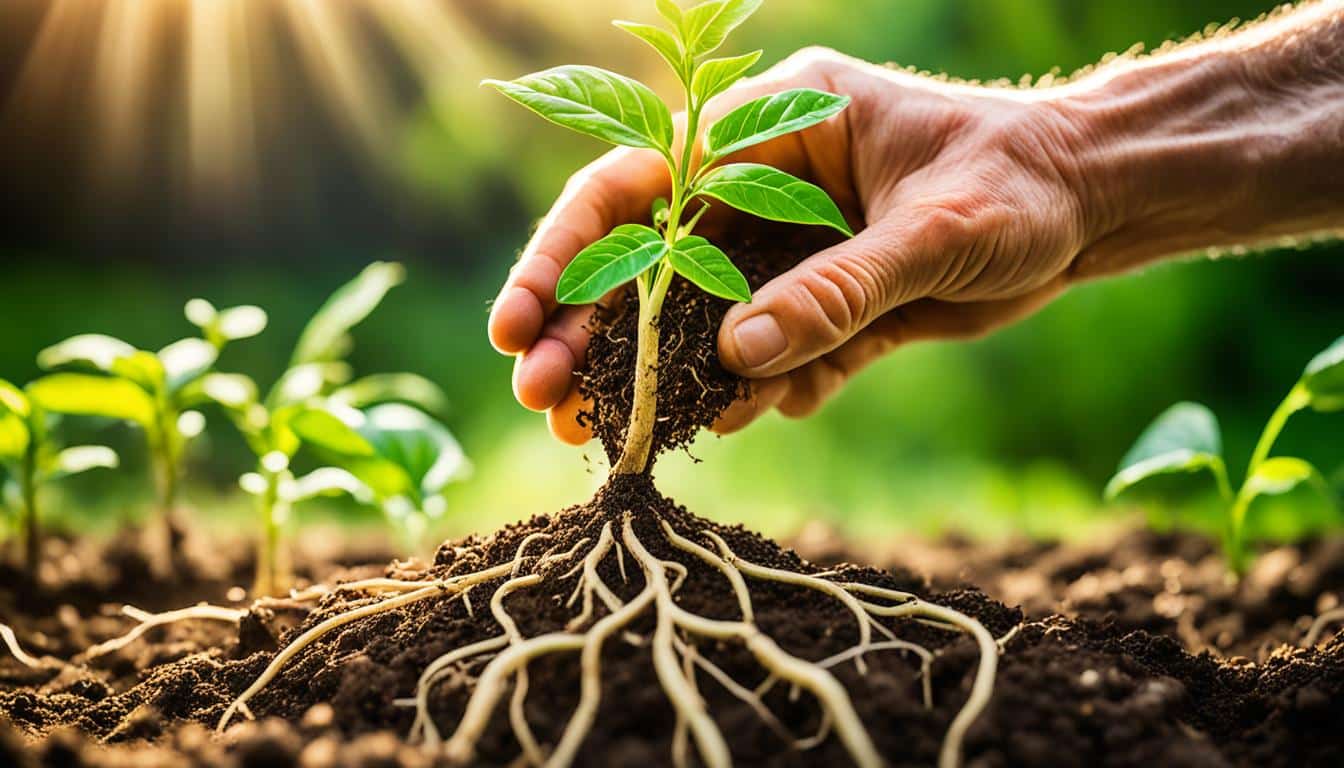
“The greatest threat to our planet is the belief that someone else will save it.” – Robert Swan
Biostimulants are now key players in sustainable farming. They’re a natural alternative to chemical-heavy solutions. And this change is crucial for us all. Market reports predict biostimulants will be worth US$10 billion by 2030.
A lot of what we do in farming isn’t very effective. Nutrient efficiency worldwide is only 30-50%. But biostimulants can help by making plants take up nutrients better, leading to healthier growth.
Excess nutrients like nitrogen and phosphorus can harm the environment. They often wash away into water systems. But biostimulants can lessen this effect. They can also help soil hold water better. This protects our rivers and helps land last longer.
Smart technology is bringing a new era to farming. It uses tools like sensors to apply biostimulants where they’re needed the most. This approach makes farming more efficient and eco-friendly.
Agricultural biostimulants are key for modern farming. They are made from various natural materials. These include amino acids, seaweed extracts, and microbe derivatives. By using these, biostimulants help improve crop health and yield. They are a big part of making farming more sustainable.
Biostimulants come from nature. They are substances that make plants grow better. Unlike chemicals, they work by helping plants use nutrients more effectively. This makes the plants tougher against things like bad weather and pests.
They also improve how plants absorb nutrients. This makes the plants healthier and able to fight off diseases. They are important for building a stronger, more natural way to farm.
Using biostimulants is a big step towards sustainable farming. They reduce the need for harmful chemicals. This helps the soil and environment stay healthy. They also make the farm more resilient, meaning it can recover faster from challenges.
Many studies have shown the benefits of biostimulants. They help plants grow better. This includes more flowers, fruit, and bigger harvests. They also help plants deal with tough situations like lack of water or cold weather.
Interestingly, biostimulants can make plant roots grow more. This helps them take up more water and nutrients from the soil. It also leads to stronger, healthier plants from the start. Using different types together can really boost these benefits. They can be used in various ways, like on seeds, on the ground, or sprayed on leaves.
| Year | Study | Focus | Ratio |
|---|---|---|---|
| 2002 | Stockdale E.A. et al. | Soil fertility in organic farming systems | 301-308 |
| 2019 | Szparaga A. et al. | Agronomic and economic effects in common bean cultivation | 4575 |
| 2021 | Campobenedetto C. et al. | Improvement of salinity tolerance in tomato plants | 354 |
| 2020 | Campobenedetto C. et al. | Enhanced heat stress tolerance in cucumber seed germination | 836 |
| 2016 | Le Mire G. et al. | Plant biostimulants and biocontrol strategies in cultivated ecosystems | 299-313 |
As we keep using and learning about biostimulants, we see their future role in farming.
Agriculture is changing a lot due to new tech and data use. These changes use data to farm better, mixing nature with tech. Precision tools and big data are making farming smarter, especially with biostimulants.
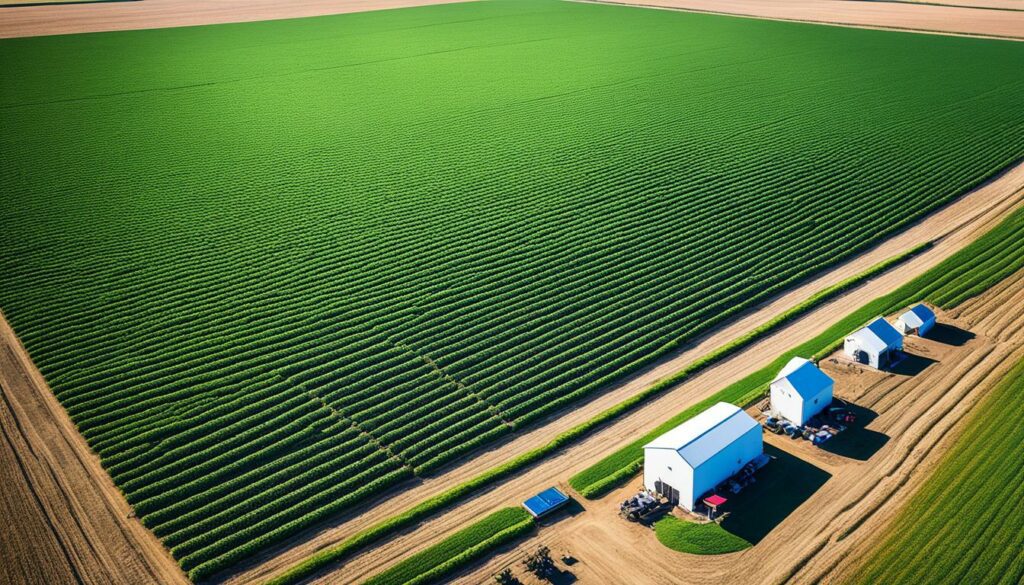
Today, farming uses many tech tools, from soil sensors to weather stations. These tools give farmers real-time data on farming conditions. Precision farming tools like Farm21’s soil moisture sensors help by giving accurate info on soil. This lets farmers use biostimulants more effectively for their crops.
Biostimulants like microbial products and seaweed extracts improve soil and help plants grow. This tech approach makes farming better and more eco-friendly. It cuts down the need for chemicals, boosting farm sustainability.
Big data is turning farming into a data-rich field. It uses lots of info to make farming decisions smarter. Farmers study data on biostimulants and crop yield patterns to farm better. This makes biostimulants work well and in a sustainable manner for every farm.
Data-driven farming is making our farming ways more forward-thinking and predictive. Companies like Syngenta and Driscoll’s are already benefiting from tech, showing its real-life farming value. We look forward to even more efficient and greener farming with tech’s constant progress.
Biostimulants are changing farming by making plants grow more using natural ways. They boost the health of plants, making them tougher and more productive. This is great news for farmers facing today’s tough challenges.
They work by waking up the plant’s natural features, making it stronger inside. This helps plants take in more food and grow better roots. They also make the soil around the plants better. This ensures the plants get all the needed nutrients.
Biostimulants help plants make better use of sunlight. This means they get more energy, grow bigger, and produce more. They also help plants deal with tough conditions like not enough water, too much salt, or extreme temperatures.
The market for biostimulants should hit US$10 billion by 2030. With not all plant food being used well, these products will be key to getting more crops, especially under tough conditions. These hard situations can normally reduce the amount of food we can grow by a lot.
Also, they help nature by making sure plants use food better. Too much food in water can hurt it, causing water plants to grow too much, which harms the ecosystem. Using biostimulants means this happens less, making farming kinder to the environment.
| Feature | Impact |
|---|---|
| Nutrient Efficiency | 30% to 50% |
| Yield Gap Due to Abiotic Stress | 60–70% |
| Projected Market Value by 2030 | US$10 billion |
To sum up, using biostimulants in farming boosts how plants make food and use nutrients. This means stronger, healthier plants that can grow against the odds. It’s good news for farmers and for our future food supply.
When we look at biostimulants versus traditional agricultural chemicals, it’s key to see their differences. Traditional ways use chemical fertilisers and pesticides. They follow a set way of applying them. However, biostimulants work more like nature does. They use a unique approach that boosts the plant’s own processes.
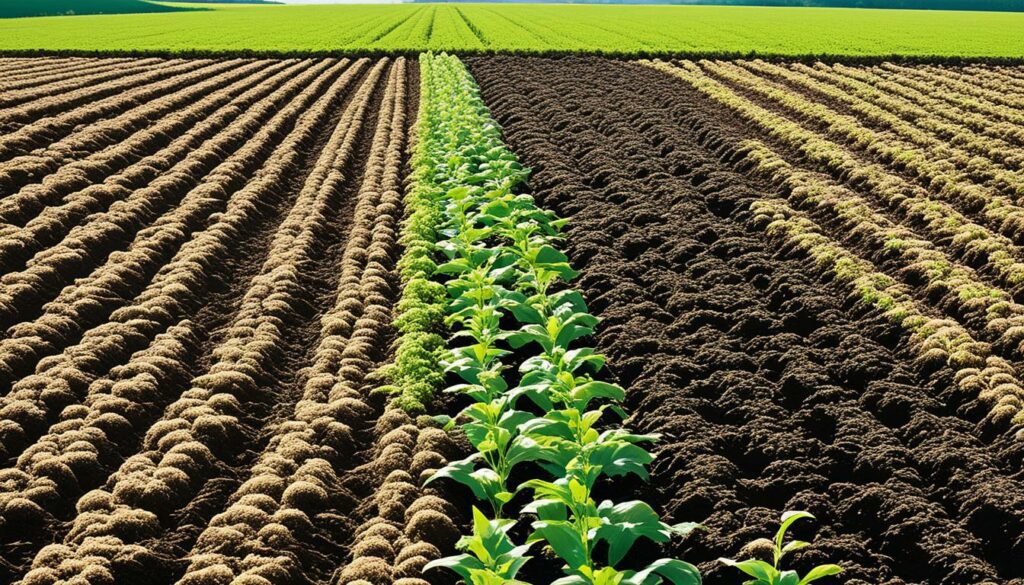
The biostimulants vs. fertilisers debate is about what they do. Biostimulants are made from natural things like amino acids and good microorganisms. They help plants grow better in an earth-friendly way. This is unlike traditional fertilisers, which can harm soil and water. Biostimulants can be made just right for each crop and soil. They use modern tools and information to do this.
The good environmental impact of biostimulants is clear. They cut down on chemical use in farming. This helps stop nutrient runoff and makes soil healthier. The soil gets more alive, which is good for crops. Big companies like Syngenta and Archer Daniels Midland have shown these benefits. They use data and special methods to keep helping the earth. This keeps agriculture strong and ready for the future.
To end, moving to biostimulants from old chemicals is a big change for the better. It means we use fewer man-made things and get along better with nature. Adding new farming tech makes biostimulants even more helpful. This way, we make farming healthier and more successful everywhere in the world.
Biostimulants help plants grow better and keep the soil healthy. There are three main types: seaweed extracts, microbial biostimulants, and humic and fulvic acids.
Seaweed extracts are packed with good stuff like amino acids and minerals. They make plants grow better, take in more nutrients, and cope with tough conditions. This helps crops produce more flowers and fruit, leading to higher yields.
Microbial biostimulants add helpful microbes like friendly bacteria and mycorrhizae to soil. They boost soil health, root growth, and how well plants use nutrients. Organica’s MagicGro, for instance, helps keep soil in great shape, keeps away pests, and supports eco-friendly farming.
They’re particularly good for making crops stronger against things like drought and salt.
Humic and fulvic acids come from old plant matter. They make the soil better, help more nutrients get to plants, and make plants use nutrients more efficiently. These acids are vital for soil health as they grow bigger roots that draw in more water and nutrients.
This also makes seeds sprout faster, grow stronger, and helps plants to stand out more.
| Biostimulant Type | Key Benefits | Primary Ingredients |
|---|---|---|
| Seaweed Extracts | Enhanced plant growth, nutrient uptake, and stress resistance | Amino acids, vitamins, minerals |
| Microbial Biostimulants | Improved soil fertility, root growth, and nutrient uptake | Non-pathogenic bacteria, mycorrhizal fungi |
| Humic and Fulvic Acids | Improved soil structure, nutrient availability, and uptake efficiency | Decomposed plant material |
Using biostimulants can really boost crop growth. It’s key to apply them in ways that suit your crops, soil, and weather. This ensures you get the most out of them.
To make biostimulants work best, choose your application method carefully. This could mean spraying leaves, treating seeds, or drenching soil. Whatever you pick, make sure it matches the biostimulant’s goal. Using tools that track when and how much you apply can really help.
How well biostimulants work depends on the soil, the weather, and what your crops need. Take time to think about these before using biostimulants
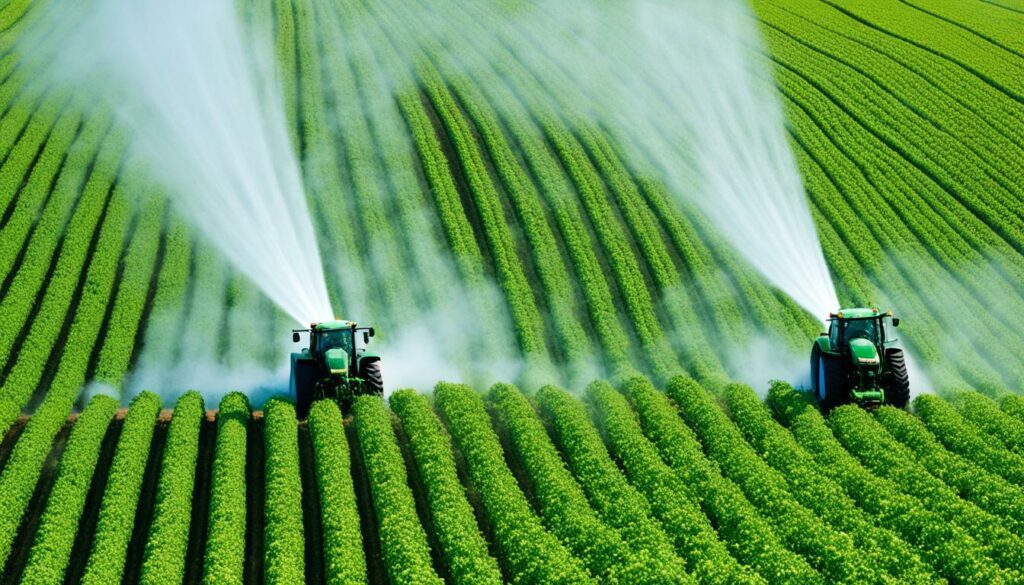
| Factor | Considerations | Optimisation Technique |
|---|---|---|
| Soil Type | Mineral content, moisture levels, pH balance | Soil testing and tailored amendments |
| Climate | Temperature, rainfall, sunlight exposure | Adapt application timing to weather forecasts |
| Crop Type | Nutrient needs, growth cycle, stress tolerance | Select biostimulant formulations specific to crop |
Using biostimulants smartly can help crops withstand changing weather and do better. Tools like soil moisture sensors let you adjust in real time. This makes your biostimulant use efficient and successful.
Biostimulants are changing how well crops grow for big farming companies. Case studies show how using these can make crops better and more sustainable.
Driscoll’s used a special biostimulant, Trichoderma harzianum, on their strawberries. This helped the plants take in nutrients better and fight off diseases. A 2019 study by Szparaga A. and others proved these benefits, showing higher crop yields and more profits.
Ocean Spray saw a boost in their cranberry harvests with Humic Acid biostimulants. A 2021 study by Campobenedetto C. and colleagues highlighted how these help plants grow stronger roots and deal with salt in the soil. This success proves how biostimulants can lead to healthier plants and better harvests.
“Our adoption of biostimulants at Ocean Spray has enabled us to not only boost our cranberry yields but also enhance the overall health and resilience of our plants.” — Dr. Rebecca Boehm, Plant Scientist at Ocean Spray
Driscoll’s and Ocean Spray show that biostimulants really work in farming today. By making crops better, these companies can keep up with what the market needs.
Biostimulants offer hope for better crop growth and quality in the future. With more study and use, they could become a key part of farming’s success.
Precision farming tools have greatly enhanced agriculture, especially with biostimulants. These tools include tools like soil sensors and weather stations. They make sure biostimulants are used in the best way. Also, using big data improves how we farm.
Soil sensors play a key role in farming by giving real-time data on soil. For example, Farm21 offers advanced moisture sensors. These help choose the best times to add biostimulants, making sure they work well.
Weather stations are vital in today’s farming. They share important climate data. This data helps farmers use biostimulants better. It also lets them adjust when they apply them, which boosts crops.
Big data is changing farming by studying lots of farming data. This helps see how biostimulants affect crops. By finding patterns, farmers can improve their biostimulant use. This makes farming more sustainable and productive.
| Biostimulant Benefits | Examples |
|---|---|
| Improved Plant Health | Seaweed Extracts, Microbial Inoculants |
| Increased Crop Yield | Humic Acids, Precision Application Tools |
| Sustainable Agriculture | Reduction in Chemical Use, Enhanced Soil Health |
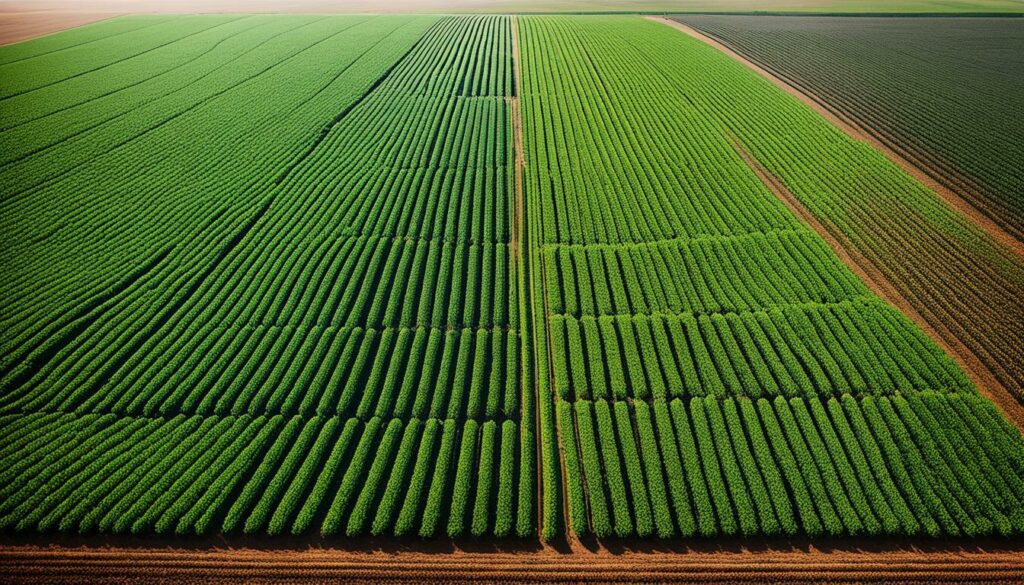
In agriculture today, stress like salinity, drought, and lacking nutrients can lower crop yield a lot. It’s key to improve how plants handle stress to keep farming productive. Many studies in journals like OENO One and Agronomy show that biostimulants help reduce these bad effects.
Things like too much salt, not enough water, and bad nutrient levels can harm crops greatly. Research has found these issues can lower crop yields by half. A study about viticulture in Portugal highlights that climate change is making these problems worse. It predicts bigger crop losses for wheat, rice, and maize.
Biostimulants help plants fight stress by boosting their natural processes. Seaweed extracts, from types like Ascophyllum nodosum and Durvillaea potatorum, are very beneficial. They improve root growth, increase antioxidants, and help plants fight off stress better. Certain nutrients, like Zn and Mn, make plants better at handling cold, as seen in Kappaphycus alvarezii against cold stress.
Together, biostimulants help plants deal with stress by making their natural defences stronger. This allows them to produce steady yields, even in harsh environments. Studies in Agronomy and Cienc. E Tec. Vitivinic. show the big help biostimulants give against heat and salt stress in crops.
| Biostimulants Application | Stress Type | Impact |
|---|---|---|
| Seaweed Extracts | Cold Stress | Enhanced cold tolerance in crops and algae species |
| Microbial Biostimulants | Heat Stress | Improved tolerance in turfgrass and other crops |
| Humic and Fulvic Acids | Salinity Stress | Alleviated salt stress and boosted plant growth |
Using biostimulants not only lessens the direct impacts of stress but also builds up crops for future challenges caused by climate change and other harms we do to the planet. By including these natural strong helpers, we can make farming more sustainable and successful.
Biostimulant seed treatments are a new boost for farming, improving seed sprouting and plant growth. Companies like Acadian Plant Health™ lead this with seaweed extract from Ascophyllum nodosum. It makes crops stronger.
There are many good things about using biostimulants on seeds. They make roots grow better, helping plants take in more nutrients and water. This makes plants stronger and healthier. It also makes them better at surviving tough environmental conditions like drought or salty soil.
New technologies have made biostimulant seed treatments even better. Acadian Plant Health™ tested these treatments worldwide on crops like wheat and soy. Their ‘Asco Plus’ seed treatment, using Ascophyllum nodosum extract, improves seeds’ growth and early life. It shows how innovation and care for the earth come together in farming.
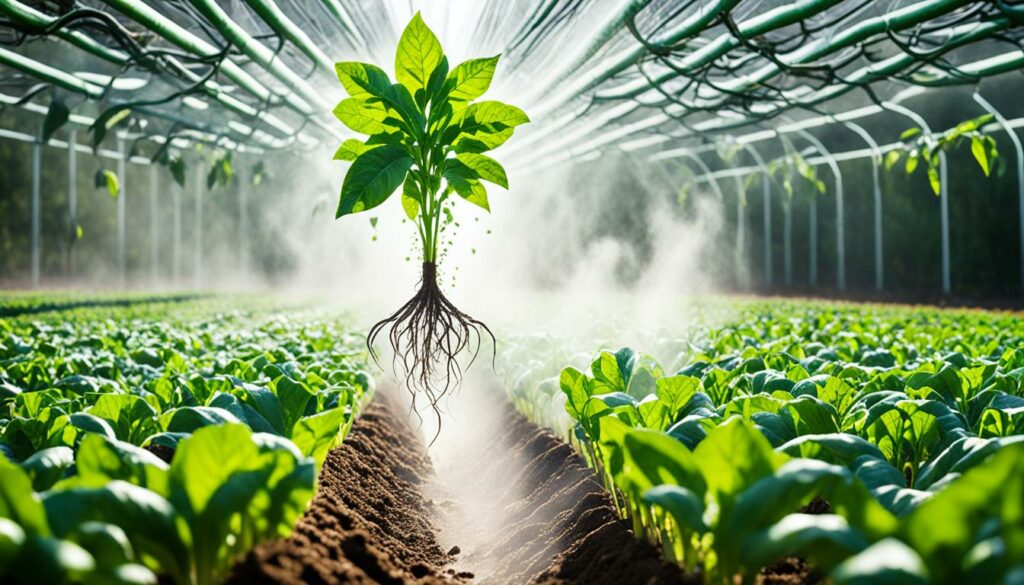
These treatments are not just about better sprouting. They help produce more food sustainably. This is key to feeding a growing world.
| Aspect | Traditional Methods | Biostimulant Seed Treatments |
|---|---|---|
| Root Development | Moderate | Enhanced |
| Stress Tolerance | Limited | High |
| Nutrient Uptake Efficiency | Standard | Increased |
| Environmental Impact | High | Low |
In today’s agriculture, making plants use nutrients better is key. Biostimulants help by making good friends between roots and soil. This is very important because usually, only 30% to 50% of fertiliser directly helps the crops, as studies worldwide have found.
These helpers make the soil work better by letting plants grab nitrogen, phosphorus, and potassium more easily. A study by Stockdale et al. in 2002 showed that using biostimulants can make organic farms more fertile. This means we don’t waste as much fertiliser, helping the environment by lessening pollution.
Zhang et al. (2017) discovered that biostimulants can even change the types of microorganisms in soil. This is great news, especially for crops like common beans. A 2019 study by Szparaga et al. found that using biostimulants here is good for the crops and the pockets of farmers.
| Biostimulant Type | Primary Function | Key Benefits |
|---|---|---|
| Humic and Fulvic Acids | Enhance soil quality | Improved nutrient uptake efficiency |
| Seaweed Extracts | Provide essential nutrients | Enhanced rhizosphere enhancement |
| Microbial Biostimulants | Boost plant growth | Promotes nutrient cycling in soil |
Using biostimulants makes crops stronger and able to fight the challenges of farming today. They help increase yield, save resources, and make farms tougher against the environment.
In modern farming, biostimulants play a key role in sustainable crop growth. They help in farming while protecting nature and ensuring we have enough food. By looking at how these products affect nature and food, we see they lower the need for fake fertilizers. They also make the soil richer and help feed the world safely.
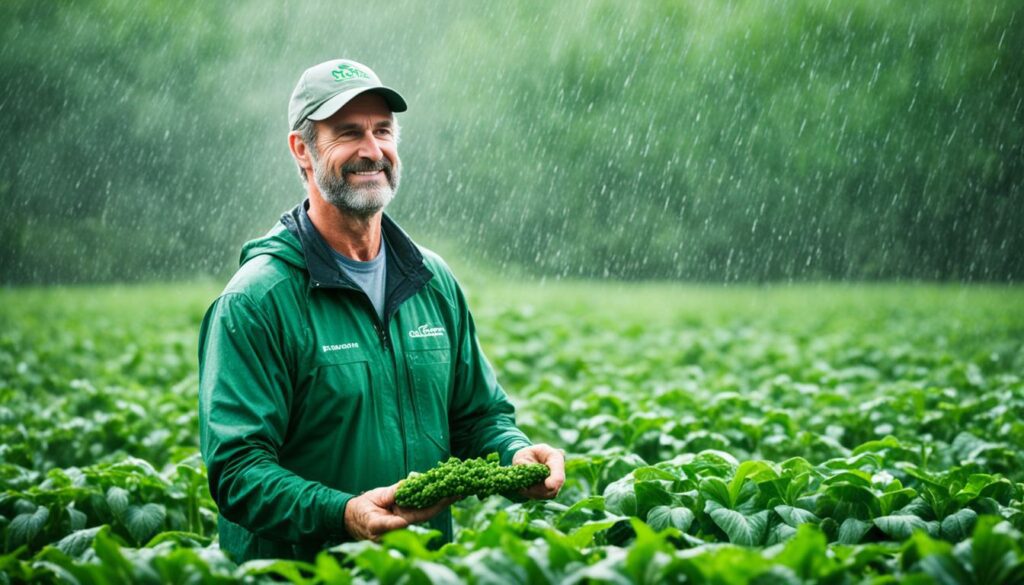
Biostimulants help us farm with fewer artificial chemicals. This cuts down on the bad effects of regular farming. They’re a safe choice, filling in when plants have a hard time growing healthy. This change is good for the Earth and helps farmers work in a way that keeps giving back to nature.
These products make the soil healthier by using nutrients better, up to half more effectively. They also help the tiny life in the ground, which helps plants grow and keeps nature diverse. A study by Shahrajabian and others in 2021 showed that biostimulants are perfect for using less but still making the soil strong. This is great for the land over time.
With more and more people to feed, biostimulants make our crops strong and grow well. They fight off bad conditions. Works by Mandal and Rouphael show how good biostimulants are for plants against tough times. The market for these products is growing fast, showing their big role in feeding the world better by 2030.
| Benefit | Impact |
|---|---|
| Reducing Synthetic Inputs | Less environmental footprint and toxicity |
| Improving Soil Health | Enhanced nutrient efficiency and soil biodiversity |
| Ensuring Food Security | Robust crop yields and resilience to stresses |
Biostimulants are set to be more and more important in farming. Works like the one by Kapoore and colleagues in 2021 show new uses for these products, making farming more sustainable. This strengthens farming, making sure we have enough safe food for the future.
The biostimulants industry is set for big growth. From 2023 to 2032, we expect its global market size to jump from USD 3.64 billion to USD 9.75 billion. This shows a steady CAGR of 11.69%. The main reasons for this growth are the rising need for eco-friendly farming and the use of advanced farm techniques.

The biostimulant market is growing fast. Seaweed extracts are becoming popular for their benefits. Also, non-microbial ingredients like humic acids and biopolymers are effective in enhancing plant health.
Changes in regulations are big drivers of industry growth. The Plant Biostimulant Act is being worked on to make product approval easier. This is good for the market and builds trust. Companies like Bayer AG are adjusting their work to meet new rules and focus on being eco-friendly.
Precision agriculture and biostimulants are a great match. Tools like soil sensors and weather stations help farmers use biostimulants in the best way. This approach ensures farms get the most out of such products.
| Market Aspect | Details |
|---|---|
| Market Size (2023) | USD 3.64 billion |
| Projected Market Size (2032) | USD 9.75 billion |
| Leading Active Ingredient | Seaweed Extracts |
| Key Regulatory Initiative | Plant Biostimulant Act |
| Primary Application Segment | Foliar Application |
| Top Market Growth Driver | Integration with Precision Agriculture |
In conclusion, the biostimulants market’s future looks bright. This is mainly because of new regulatory efforts and their great fit with precision agriculture techniques.
Biostimulants are key in modern farming, improving plant health and boosting crop yields. They also help in making farming more sustainable. By 2021, the plant biostimulants market was set to reach USD 3 billion. This shows how much it’s growing and changing farming.
They are a great choice over traditional fertilizers, with the aim to reduce chemical fertilizers by 30% by 2050. Thanks to groups like the European Biostimulant Industry Council, we’re getting clear rules and proof on how well these products work. A new law in Europe set to appear by 2024 will make biostimulants even more important in farming.
Many studies have shown that biostimulants really do help crops grow better. They have benefits for many types of plants and areas. Biostimulants like chitosan and humic acids make plants use nutrients better, face stress, and grow healthier.
Summing up, biostimulants are crucial for farming’s future, blending innovation with sustainability. As the field grows with new tech and rules, they will improve farming and ensure we have enough healthy food. By choosing eco-friendly options like biostimulants, we can tackle tough farm issues and grow sustainably.
Biostimulants are natural substances or tiny living things that boost crop health and output. They make crops take up nutrients better. They also help plants fight off stress and grow stronger. Key elements in biostimulants include amino acids, humic acids, and beneficial microbes.
Biostimulants are critical for eco-friendly farming. They keep the soil healthy and reduce the need for man-made chemicals. By mimicking nature’s processes, they help farms stay green. This approach supports our planet’s future.
Modern tools like precision farming and analysing big data are changing agriculture. They let farmers use biostimulants more effectively. By using detailed information, farmers can grow more food with less impact on the environment.
Biostimulants work by making plants use nutrients better. They improve how plants photosynthesise. This leads to stronger plants, bigger harvests, and crops that can handle tough situations.
Biostimulants are not like regular fertilisers. They’re more personal, boosting a plant’s own abilities. This means less need for chemicals and more sustainable farming.
There are several kinds of biostimulants: seaweed extracts, helpful microbes, and acids from the earth. Each type does something special for the soil and the plants. They help make the soil rich and promote better plant growth.
To use biostimulants well, farmers should personalise their approach. They need to know about the soil, the weather, and the plants. Advanced farming tech helps do this accurately. This way, farmers can get the best results without harming the environment.
Sure. Driscoll’s used Trichoderma harzianum to boost their strawberry yield. Ocean Spray used Humic Acid to improve cranberry farming. These cases show how biostimulants can really make a difference for crops.
Precision farming tools give farmers the exact info they need to use biostimulants well. They include soil sensors and weather tracking. This information helps in treating plants just right, improving their health without wasting resources.
Biostimulants make plants stronger against harsh conditions by helping in various ways. They develop better roots, boost natural defences, and increase stress tolerance. This means plants can survive tough times and keep producing well.
Using biostimulants on seeds makes them tougher and better at growing. They encourage the growth of strong roots. They also activate genes that help the plant deal with stress. This sets the stage for a productive crop.
Biostimulants help plants get more nutrients by creating a better environment around the roots. This makes the plants use nutrients more efficiently. It also means less fertiliser gets wasted, helping the environment.
Using biostimulants cuts down on the need for harmful chemicals. It makes the soil healthier and supports more kinds of life. This is good for the planet and helps in the fight against climate change.
The biostimulant market is growing a lot. This growth is driven by the need for sustainable farming and new farming technology. People are choosing more eco-friendly options, and the law is pushing for it. This makes biostimulants very important in agriculture worldwide.